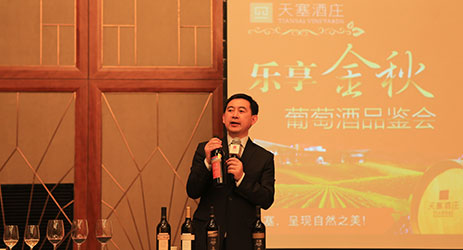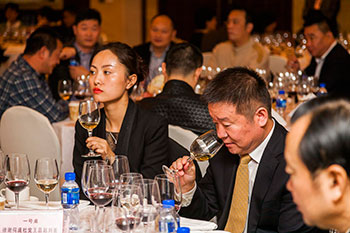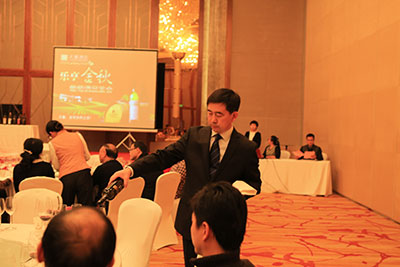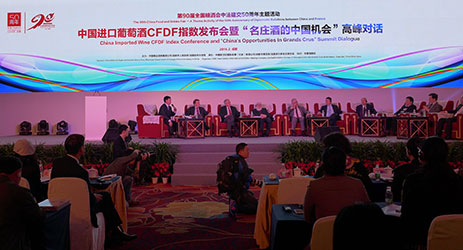Demei's View - Wine Communication from a Chinese Winemaker
After the ProWine China wine fair in Shanghai last November, I followed the Xinjiang Tiansai Vineyards to Chengdu, Nanchang and Xining until the end of the year for their tasting events. This trip gave me the chance to directly face and understand the development opportunities for wine in the second-tier cities in China (although I suppose Xining doesn't even count as a second-tier city if evaluated by the level of economic development), and the trip brought me a lot of thoughts and feelings.

Cities in China are divided into first-tier, second-tier, third-tier and fourth-tier according to their development level, comprehensive economic strength, radiation impetus ability and international competitiveness. Without doubt, first-tier cities are playing a dominant role of leading and radiating in national social activities such as finance, service, innovation, circulation, consumption and so on. Beijing, Shanghai and Guangzhou are generally considered as the first-tier cities, and Shenzhen was added to this group in recent years. Tianjin and Chongqing are municipalities directly under the central government, but they are not listed as first-tier cities in many industries because of the restriction of their comprehensive economic strength and radiation impetus ability. Most provincial capitals and some cities in the economically developed coastal areas are considered second-tier cities. The total number is around 30, but the lists in different industries are more or less different due to various evaluation systems. Other smaller cities (in terms of economic aggregate and population size) are the third-tier and fourth-tier cities.
The expansion of market of a new product or the rise of a new industry normally starts from the first-tier cities and gradually carries forward to the second-tier, third-tier and fourth-tier cities. It is the same for the development of the wine consumption market in China. At the end of last century, the market began to grow in the first-tier cities listed above, and the consumption drove the development of the Chinese wine industry. Then at the beginning of this century (in 2004 to be precise), the Chinese government loosened its control of foreign capital entering the retail sector. This means that wine importors and distribution companies with foreign backgrounds were able to run their businesses in day light, thus the Chinese wine scene flourished like never before. However, before the Beijing Olympics (in 2008), wine consumption mainly happened in the first-tier cities, and remained in a very primary state in other parts of China.

The Beijing Olympics is always considered the dividing line between different phases of the development of the Chinese wine scene, but the fundamental cause of the development of wine consumption in the second-tier cities should not be the event itself. The Beijing Olympics brought a chance for China to understand the world more comprehensively. By coincidence, it also happened at the beginning of another global economic crisis. In order to cope with the economic crisis, at the end of 2008, Chinese central government decided to invest CNY4 trillion to stimulate the economic development. I am not familiar with economy, so I am not going to appraise if the decision was rational, but there is no doubt that the Chinese wine industry, as a part of the socioeconomic system, has directly or indirectly received a share of the investment. Chinese entrepreneurs started to buy en primeur in large scale; some of them even purchased wineries. Many people were hyping with the ‘China’ concept when releasing the 2009 vintage en primeur, with some producers even adding Chinese culture elements on the wine label (Chateau Mouton Rothschild 2008) or wine bottle (Chateau Lafite Rothschild 2008) to attract Chinese wine drinkers. The participation of Chinese capital steadily pushed the price of en primeur up, and led to experts to warn on ‘en primeur price bubble’. The film Red Obsession was created in this context.
No matter they were buying en primeur and/or wineries, none of the Chinese investors were seriously planning to sell wines in France or in other area outside China. Instead, they all knowingly think about shipping the wines back to the Chinese market. The capital pushed the development of wine consumption from the first-tier cities to the second-tier. Almost in the same period, wine bodies like UGC (adding Grand Tasting in Chengdu in March 2011), CIVB (organising Bordeaux wine training in seven Chinese cities in May 2011) and Inter Rhone expanded their tasting and promotional events in second-tier Chinese cities, followed by Wine Australia (starting the A+ Australian Wine training project in China since October 2011), California Wines (setting up China office in September 2011) and other organisations which implemented a series of promotional activities in many Chinese cities. The influence of wine has gradually increased in the second-tier and third-tier cities in China.

After the development in more than ten years’ time, the wine consumption in the first-tier cities became mature, and has formed some medium-sized grown-up consumer groups. The people in these groups are able to lead the local wine consuming trends. The proprietors who have a head start in these cities continue to enjoy the advantages, and raise the threshold for those who tried to break into. But it is a different picture in the second-tier cities. Because the start of wine consumption is later here than the first-tier cities, the methods that were proved successful in the first-tier cities ten years ago can be directly used here without racking one’s brain to draw attention of the wine drinkers. The consumers in the second-tier cities haven’t formed a fixed perspective of wine flavours and styles, nor have any bias. They are more inclusive to all wines. If the first sip of wine that touches his/her heart is your product, he/she will be your loyal promoter – that's if your wine can continuously bring him/her surprise. The size of second-tier city is relatively small, so the direct communication between friends is more often in these areas, the influence of ‘opinion leaders’ is also stronger. This environment is more suitable for the spread of experiential consumption products – the ‘off-site’ influence a successful tasting event in these cities can bring is more effective than in the first-tier cities.
Of course, the second-tier cities are less developed than the first-tier ones, and there are more difficulties in terms of hardware facilities and software services when organising promotional events in the second-tier cities. Without careful preparation in advance, the event organiser may feel rather frustrated. Thus, it is very important to find a capable local partner who can help with developing and maintaining the market when entering the second-tier cities.
Translated by Nina Fan Feng / 冯帆
All rights reserved by Future plc. No part of this publication may be reproduced, distributed or transmitted in any form or by any means without the prior written permission of Decanter.
Only Official Media Partners (see About us) of DecanterChina.com may republish part of the content from the site without prior permission under strict Terms & Conditions. Contact china@decanter.com to learn about how to become an Official Media Partner of DecanterChina.com.



Comments
Submit